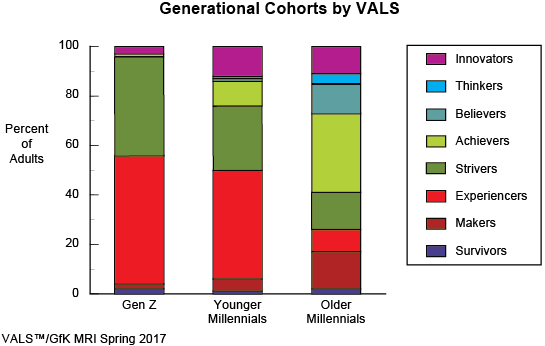Generation Z and Millennials January 2018
Want more free featured content?
Subscribe to Insights in Brief

In 2015, when the first Generation Zers turned age 18, media such as Fast Company, HuffPost, and The New York Times wrote articles about how Generation Z differs from Millennials. To date, given the lack of large-sample survey research about the youngest cohort, most commentators are consultants and authors (promoting their services and books) writing attention-grabbing copy on the basis of observations, anecdotes, and small convenience samples of people in their late teens. As of spring 2017, The Survey of the American Consumer, GfK MRI offers reliable data upon which to make valid analyses of Gen Z and a comparison with Millennials.
Because definitions of generations sometimes use various years, a definition of generational cohorts in use for this paper will be helpful (see Table 1). Because of the size of the Millennials cohort, we divide the group into younger and older subgroups as Baby Boomers previously appeared because of that cohort's size.
Table 1Age-Cohort Definitions |
||
|---|---|---|
| Age Cohort | Born Between | Current Age Between |
Source: GfK MRI |
||
| Generation Z | 1997–2010 | 18 and 20 |
| Younger Millennials | 1988–1996 | 21 and 29 |
| Older Millennials | 1977–1987 | 30 and 39 |
| Gen Xers | 1965–1976 | 40 and 52 |
| Younger (Late) Baby Boomers | 1956–1964 | 53 and 61 |
| Older (Early) Baby Boomers | 1946–1955 | 62 and 71 |
Most media comments about Gen Z range from the obvious—such as smartphone and social-media availability and ethnic diversity—to specifics, such as eight ways in which members of Gen Z differ from Millennials. One author claims that Gen Z in comparison with Millennials is less focused, better at multitasking, more likely to look for bargains, more likely to go straight into the workforce, more entrepreneurial, highly individualistic, and more global and has higher expectations. Lucie Greene (worldwide director of the Innovation Group at J. Walter Thompson) tells us that Gen Z members are "conscientious, hard-working, somewhat anxious, and mindful of the future." Dan Schawbel (managing partner of Millennial Branding) cautions advertisers they must "communicate in five words and a big picture" to reach Gen Z. Dan Gould (a trend consultant for Sparks & Honey advertising) advises that Generation Z has embraced "anonymous social media platforms like Secret or Whisper, as well as Snapchat where incriminating images disappear almost instantly" in efforts to protect its privacy. Another commentator characterizes Gen Z as "mature and in control," using a US Centers for Disease Control and Prevention survey of risky behaviors about alcohol and seatbelt use of high school students to draw that conclusion. Saeculum Research (Virginia Beach, Virginia), a social-trends consultancy, writes that because of concerns about privacy, their cautious nature, and their interest in sensible careers, "Generation Z starts to look less like the brash Millennials and more like [its] grandparents." We read about Gen Z reverting to their grandparents' era several times.
Let's look at some actual data. GfK MRI studies contain several series of attitude questions. Using the above media comments as a guide, we selected seven attitudes that correspond with some comments about Gen Z. Table 2 shows a comparison of the selected attitudes by generational cohort (higher-than-average incidences have a blue shade).
In summary, Gen Z is no more or less likely than average (51% of all adults) to think that people put too much private information on the internet. Gen Z is less likely than all adults to agree that marriage should be heterosexual only. Gen Zers are more likely than all adults to text more than they talk on their phones, to have high expectations of technology (quality of cell-phone video), to use apps instead of websites, to eat organic foods, and to expect their brands to support social causes. But hold the excitement: Younger Millennials—and in several instances, Older Millennials—agree with Gen Z in their attitudes.
Be cautious! Don't confuse social trends with Gen Z characterizations.
Table 2Comparison of Selected Attitudes by Generational Cohort |
|||||||
|---|---|---|---|---|---|---|---|
| Attitude (Mostly Agree) | All Adults (Percent) | Gen Z (Percent) | Younger Millennials (Percent) | Older Millennials (Percent) | Gen X (Percent) | Younger Boomers (Percent) | Older Boomers (Percent) |
Source: VALS™/GfK MRI Spring 2017 |
|||||||
| I think people put too much private information about their lives on the internet. | 51 | 45 | 43 | 47 | 50 | 60 | 56 |
| Marriage should be legal between a man and a woman only. | 35 | 20 | 23 | 26 | 33 | 45 | 41 |
| I text more than I talk on my phone. | 29 | 42 | 41 | 39 | 31 | 17 | 22 |
| I expect the quality of video on my cell phone to be as good as that on my TV. | 22 | 36 | 32 | 28 | 23 | 16 | 16 |
| On my cell phone, I prefer to use apps instead of websites. | 20 | 29 | 26 | 23 | 21 | 11 | 18 |
| I regularly eat organic foods. | 13 | 18 | 17 | 18 | 11 | 11 | 10 |
| I expect the brands I buy to support social causes. | 9 | 15 | 11 | 10 | 8 | 5 | 7 |
Several technology behaviors (see Table 3) show the same pattern: Gen Z incidences are higher than for all adults but in many cases (except Snapchat visits) similar to those of Younger Millennials. Higher-than-average incidences have a blue shade.
Table 3Comparison of Selected Behaviors by Generational Cohort |
|||||||
|---|---|---|---|---|---|---|---|
| Behavior | All Adults (Percent) | Gen Z (Percent) | Younger Millennials (Percent) | Older Millennials (Percent) | Gen X (Percent) | Younger Boomers (Percent) | Older Boomers (Percent) |
Source: VALS™/GfK MRI Spring 2017 |
|||||||
| Have a cell phone | 92 | 96 | 97 | 98 | 96 | 93 | 87 |
| Have an iPhone | 39 | 61 | 46 | 44 | 41 | 36 | 32 |
| Visited Facebook in past 30 days | 65 | 79 | 85 | 79 | 71 | 56 | 48 |
| Used Snapchat in past 30 days | 15 | 73 | 38 | 14 | 8 | 4 | 2 |
| Used Twitter in past 30 days | 14 | 39 | 24 | 16 | 13 | 10 | 5 |
The use of demographics, attitudes, behaviors, or any combination of the three has limited use when developing a cohort profile, because cohorts are not monolithic. Generational cohorts by VALS™ provide both understanding and insights.

For example, the majority of young adults enter the VALS system as Experiencers. Experiencers explore many life choices as they develop their identity. Typically, they gravitate toward new products, services, and ways of doing things because they want to stand out as individuals (and to be the center of attention). Experiencers' personality is consistent regardless of age. Differences between Gen Z and Millennials cohorts are a function of the proportion of the consumer groups within the cohort. In this example, Gen Z and Young Millennials express many of the same attitudes and exhibit many of the same behaviors because Experiencers represent 52% of Gen Z and 45% of Young Millennials. Strivers, the second-largest group in the Gen Z cohort, are more likely than Experiencers to be the reason more than one commentator characterized the cohort as pragmatic and cautious, interested in sensible careers, and willing to bypass student loans to attend an expensive four-year college by going straight into the workforce from high school, taking online courses as necessary. Experiencers lead; Strivers follow to the best of their ability to do so.
A look at the same selected attitudes in Table 2 by VALS (see Table 4) reveals which VALS groups predominate in characterizing each cohort (higher-than-average incidences have a blue shade). For example, the high incidence of agreement about technology attitudes is a function of the high proportions of Experiencers in Gen Z and Millennials cohorts.
Table 4Comparison of Selected Attitudes by VALS |
|||||||
|---|---|---|---|---|---|---|---|
| Attitude (Mostly Agree) | All Adults (Percent) | Innovators (Percent) | Thinkers (Percent) | Achievers (Percent) | Strivers (Percent) | Experiencers (Percent) | Makers (Percent) |
Source: VALS™/GfK MRI Spring 2017 |
|||||||
| I think people put too much private information about their lives on the Internet. | 51 | 49 | 58 | 48 | 45 | 45 | 59 |
| Marriage should be legal between a man and a woman only. | 35 | 7 | 37 | 33 | 25 | 31 | 40 |
| I text more than I talk on my phone. | 29 | 34 | 20 | 37 | 33 | 42 | 28 |
| I expect the quality of video on my cell phone to be as good as that on my TV. | 22 | 22 | 13 | 25 | 26 | 37 | 19 |
| On my cell phone, I prefer to use apps instead of websites. | 20 | 21 | 15 | 21 | 22 | 30 | 20 |
| I regularly eat organic foods. | 13 | 24 | 11 | 12 | 13 | 21 | 9 |
| I expect the brands I buy to support social causes. | 9 | 8 | 5 | 7 | 7 | 16 | 8 |
Depending on a company's marketing objective, the ability to discriminate between consumer groups meaningfully is the difference between success and failure. Although a study of generational cohorts—especially Gen Z—makes for interesting reading, be cautious when acting on a characterization of the group's personality, because the cohort is a composition of groups that represent a good target and groups that do not.
Visit the VALS Why-ology Library for previously featured items and additional featured VALS content. Be sure to visit the VALS homepage for more articles.